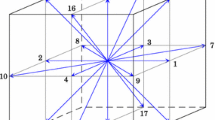Abstract
Coarse grid lattice Boltzmann models (LBM) and computational fluid dynamics (CFD) are compared in building simulations. Three simulations are used to assess the different numerical models: (i) a 2D isothermal flow case, (ii) a 3D isothermal flow case and (iii) a 2D non-isothermal flow case. Both models predicted the correct flow patterns and temperature field and could be used for real time (RT), near real time (NRT) and faster than real time (FRT) simulations without loss of accuracy on multi-core processors. The results indicate that the coarse grid CFD is both faster and more time accurate than the LBM for unsteady simulations.
Similar content being viewed by others
References
ANSYS (2010). ANSYS Fluent User’s Guide.
Beitelmal AH, Patel DC (2007). Thermo-fluids provisioning of a high perfrormance density data center. Distributed and Parallel Databases, 21: 227–238.
Blay D, Mergui S, Niculae C (1992). Confined turbulent mixed convection in the presence of horizontal buoyant wall jet. Fundamentals of Mixed Convection, 213: 65–72.
Chen Q (2009). Ventilation performance for buildings: A method overview and recent applications. Building and Environment, 44: 848–858.
Crouse B, Krafczyk M, Kuhner S, Rank E, Treeck CV (2002). Indoor air flow analysis based on lattice Boltzmann methods. Energy and Buildings, 34: 941–949.
Hirsch C (2007). Numerical Computation of Internal and External Flows: The Fundamentals of Computational Fluid Dynamics, 2nd edn. Burlington, USA: Butterworth-Heinemann.
Imamura T, Suzuki K, Nakamura T, Yoshida M (2005). Acceleration of steady-state lattice Boltzmann simulations on non-uniform mesh using local time step method. Journal of Computational Physics, 202: 645–663.
Kuhner S, Crouse B, Rank E (2004). From a product model to visualization: Simulation of indoor flows with lattice-Boltzmann methods. Computer Aided Civil and Infrastructure Engineering, 19: 411–420.
Kuznik F, Rusaouen G (2007). Numerical prediction of natural convection occuring in building components: A double-population lattice Boltzmann method. Numerical Heat Transfer, Part A, 52: 315–335.
Li W, Wei X, Kaufman A (2003). Implementing lattice Boltzmann computation on graphics hardware. The visual Computer, 19: 444–456.
Megri AC, Haghighat F (2007). Zonal modeling for simulating indoor environment of buildings: Review, recent developments, and applications. HVAC&R Research, 13: 887–905.
Nielsen PV (1990). Specification of a two-dimensional test case. International Energy Agency, Energy Conservation in Buildings and Community Systems, Annex 20: Air Flow Pattern Within Buildings.
Nielsen PV (2004). Computational fluid dynamics and room air movement. Indoor Air, 14(Suppl 7): 134–143.
OpenFoam (2012). OpenFoam User’s Guide, Release 2.1.1.
PowerFlow (2009). PowerFlow User’s Guide, Release 4.2.
Qiu F, Zhao Y, Fan Z, Wei X, Lorenz H, Wang J, Yoakum-Stover S, Kaufman A, Mueller K (2004). Dispersion simulation and visualization for urban security. In: Proceedings of IEEE Conference on Visualization, Texas, USA.
Schlichting H (1979). Boundary Layer Theory, 7th edn. New York: McGrawHill.
Stam J (1999). Stable fluids. In: Proceedings of SIGGRAPH 99, Los Angeles, USA.
Sukop MC, Thorne DT (2006). Lattice Boltzmann Modeling: An Introduction for Geoscientists and Engineers. Berlin: Springer.
Susin RM, Lindner GA, Mariani VC, Mendonca KC (2009). Evaluating the influence of the width of inlet slot on the prediction of indoor airflow: Comparison with experimental data. Building and Environment, 44: 971–986.
VanGilder JW, Zhang X (2008). Coarse-grid CFD: The effect of grid size on data center modeling. ASHRAE Transactions, 114(2): 166–181.
Wei X, Zhao Y, Fan Z, Li W, Qiu W, Yoakum-Stover S, Kaufman AE (2004). Lattice-based flow field modeling. IEEE Transactions on Visualization and Computer Graphics, 10: 719–729
Wei X, Zhao Y, Fan Z, Li W, Yoakum-Stover S, Kaufman A (2003). Blowing in the wind. In: Proceedings of Eurographics/SIGGRAPH Symposium on Computer Animation, Aire-la-Ville, Switzerland, pp. 75–85.
Wenisch P, Van Treeck C, Rank E (2004). Interactive indoor air flow analysis using high performance computing and virtual reality techniques. In: Proceedings of the 9th International Conference on Air Distribution in Rooms (RoomVent2004), Coimbra, Portugal.
Wu E, Zhu H, Liu X, Liu Y (2007). Simulation and interaction of fluid dynamics. Visual Computer, 23: 299–308
Zhang Z, Zhang W, Zhai Z, Chen Q (2007). Evaluation of various turbulence models in predicting airflow and turbulence in enclosed environments by CFD: Part-2: Comparison with experimental data from literature. HVAC&R Research, 13: 871–886.
Zuo W, Chen Q (2009). Real-time or faster-than-real-time simulation of airflow in buildings. Indoor Air, 19: 33–44.
Zuo W, Chen Q (2010). Fast and informative flow simulations in a building using fast fluid dynamics model on graphics processing unit. Building and Environment, 45: 747–757.
Author information
Authors and Affiliations
Corresponding author
Rights and permissions
About this article
Cite this article
Elhadidi, B., Khalifa, H.E. Comparison of coarse grid lattice Boltzmann and Navier Stokes for real time flow simulations in rooms. Build. Simul. 6, 183–194 (2013). https://doi.org/10.1007/s12273-013-0107-x
Received:
Revised:
Accepted:
Published:
Issue Date:
DOI: https://doi.org/10.1007/s12273-013-0107-x




